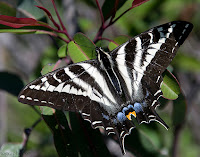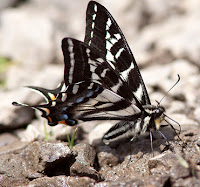However not as normal as the western tiger swallowtail, the pale swallowtail might be viewed in substantial numbers at puddling gatherings where up to a handful of or more guys could be viewed garnered. There they join other species to sip water from damp soil to obtain nutrients for mating.
Adults of Pale Swallowtail fly from April to October and are most common in May and July. Caterpillars enter their pupa stage in the fall and overwinter before emerging as adults. Eggs are laid singly on plant hosts which include members of the Ceanothus family, including buckbrush, mountain balm, and mountain lilac, as well as red alder, ccean spray, bitter cherry, and Serviceberry species.
 Caterpillar of Pale Swallowtail, to 1 3/4" (44 mm), soft green with yellow and black eyespot patterns. Chrysalis barklike, dark brown streaked with black. Preferred host plants mostly in buckthorn family, including mountain lilac and mountain balm (Ceanothus), also holly-leaf cherry (Prunus ilicifolia) and coffeeberry (Rhamnus californicus) in California, and alders (Alnus). Caterpillars are plump green with a single yellow band behind the thorax. They have two eye-shaped spots on the upper thorax which may help frighten predators. Like most swallowtails they have red wishbone shaped organ called the osmeterium which pops out from behind the head and releases a foul odor to warn off predators.
Caterpillar of Pale Swallowtail, to 1 3/4" (44 mm), soft green with yellow and black eyespot patterns. Chrysalis barklike, dark brown streaked with black. Preferred host plants mostly in buckthorn family, including mountain lilac and mountain balm (Ceanothus), also holly-leaf cherry (Prunus ilicifolia) and coffeeberry (Rhamnus californicus) in California, and alders (Alnus). Caterpillars are plump green with a single yellow band behind the thorax. They have two eye-shaped spots on the upper thorax which may help frighten predators. Like most swallowtails they have red wishbone shaped organ called the osmeterium which pops out from behind the head and releases a foul odor to warn off predators.

 6:13 AM
6:13 AM
 sadmovement
sadmovement



 Posted in:
Posted in: 






0 comments:
Post a Comment